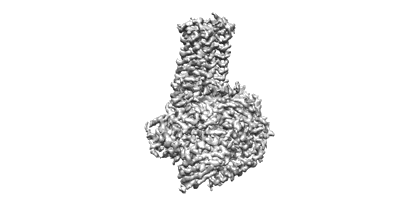EMD-37356
Cryo-EM structure of the GPR101-Gs complex
EMD-37356
Single-particle2.89 Å
 Deposition: 04/09/2023
Deposition: 04/09/2023Map released: 03/01/2024
Last modified: 30/10/2024
Sample Organism:
Homo sapiens
Sample: Cryo-EM structure of the GPR101-Gs complex
Fitted models: 8w8q (Avg. Q-score: 0.564)
Deposition Authors: Sun JP ,
Gao N
,
Gao N  ,
Yu X
,
Yu X  ,
Wang GP,
Yang F,
Wang JY,
Yang Z,
Guan Y
,
Wang GP,
Yang F,
Wang JY,
Yang Z,
Guan Y
Sample: Cryo-EM structure of the GPR101-Gs complex
Fitted models: 8w8q (Avg. Q-score: 0.564)
Deposition Authors: Sun JP
 ,
Gao N
,
Gao N  ,
Yu X
,
Yu X  ,
Wang GP,
Yang F,
Wang JY,
Yang Z,
Guan Y
,
Wang GP,
Yang F,
Wang JY,
Yang Z,
Guan Y
Structure of GPR101-Gs enables identification of ligands with rejuvenating potential.
Yang Z,
Wang JY,
Yang F,
Zhu KK,
Wang GP,
Guan Y,
Ning SL,
Lu Y,
Li Y  ,
Zhang C,
Zheng Y,
Zhou SH,
Wang XW,
Wang MW,
Xiao P
,
Zhang C,
Zheng Y,
Zhou SH,
Wang XW,
Wang MW,
Xiao P  ,
Yi F
,
Yi F  ,
Zhang C,
Zhang PJ,
Xu F
,
Zhang C,
Zhang PJ,
Xu F  ,
Liu BH
,
Liu BH  ,
Zhang H,
Yu X
,
Zhang H,
Yu X  ,
Gao N
,
Gao N  ,
Sun JP
,
Sun JP 
(2024) Nat Chem Biol , 20 , 484 - 492
 ,
Zhang C,
Zheng Y,
Zhou SH,
Wang XW,
Wang MW,
Xiao P
,
Zhang C,
Zheng Y,
Zhou SH,
Wang XW,
Wang MW,
Xiao P  ,
Yi F
,
Yi F  ,
Zhang C,
Zhang PJ,
Xu F
,
Zhang C,
Zhang PJ,
Xu F  ,
Liu BH
,
Liu BH  ,
Zhang H,
Yu X
,
Zhang H,
Yu X  ,
Gao N
,
Gao N  ,
Sun JP
,
Sun JP 
(2024) Nat Chem Biol , 20 , 484 - 492
Abstract:
GPR101 is an orphan G protein-coupled receptor actively participating in energy homeostasis. Here we report the cryo-electron microscopy structure of GPR101 constitutively coupled to Gs heterotrimer, which reveals unique features of GPR101, including the interaction of extracellular loop 2 within the 7TM bundle, a hydrophobic chain packing-mediated activation mechanism and the structural basis of disease-related mutants. Importantly, a side pocket is identified in GPR101 that facilitates in silico screening to identify four small-molecule agonists, including AA-14. The structure of AA-14-GPR101-Gs provides direct evidence of the AA-14 binding at the side pocket. Functionally, AA-14 partially restores the functions of GH/IGF-1 axis and exhibits several rejuvenating effects in wild-type mice, which are abrogated in Gpr101-deficient mice. In summary, we provide a structural basis for the constitutive activity of GPR101. The structure-facilitated identification of GPR101 agonists and functional analysis suggest that targeting this orphan receptor has rejuvenating potential.
GPR101 is an orphan G protein-coupled receptor actively participating in energy homeostasis. Here we report the cryo-electron microscopy structure of GPR101 constitutively coupled to Gs heterotrimer, which reveals unique features of GPR101, including the interaction of extracellular loop 2 within the 7TM bundle, a hydrophobic chain packing-mediated activation mechanism and the structural basis of disease-related mutants. Importantly, a side pocket is identified in GPR101 that facilitates in silico screening to identify four small-molecule agonists, including AA-14. The structure of AA-14-GPR101-Gs provides direct evidence of the AA-14 binding at the side pocket. Functionally, AA-14 partially restores the functions of GH/IGF-1 axis and exhibits several rejuvenating effects in wild-type mice, which are abrogated in Gpr101-deficient mice. In summary, we provide a structural basis for the constitutive activity of GPR101. The structure-facilitated identification of GPR101 agonists and functional analysis suggest that targeting this orphan receptor has rejuvenating potential.
